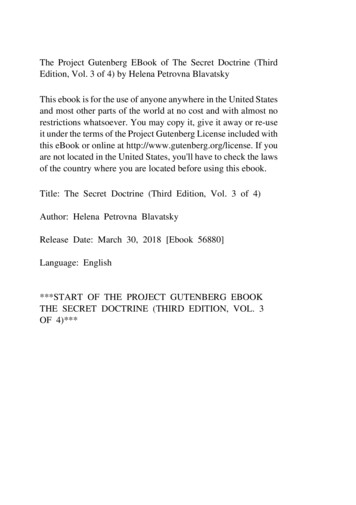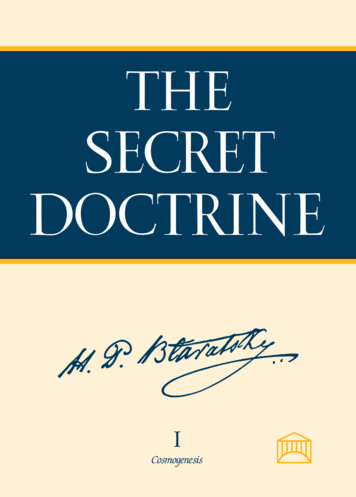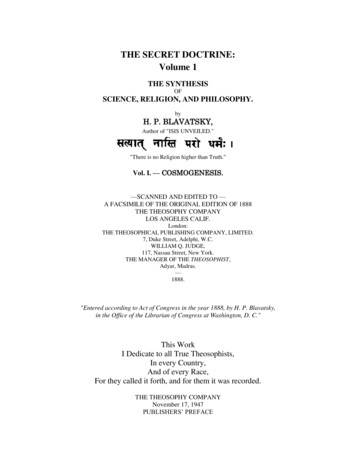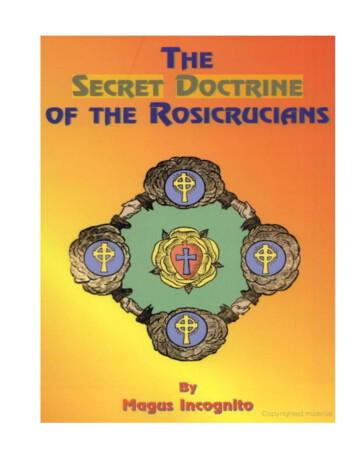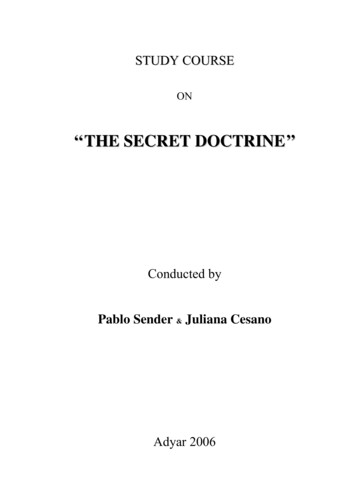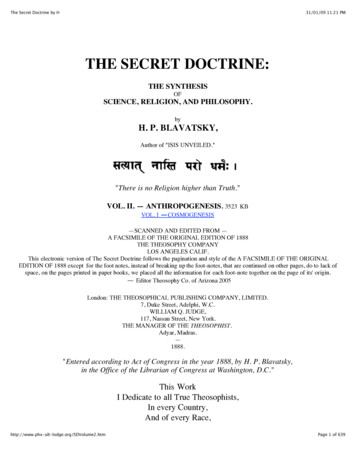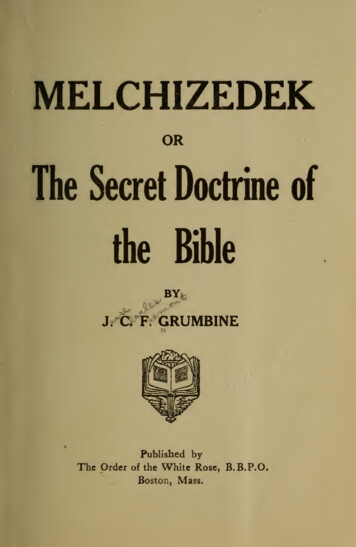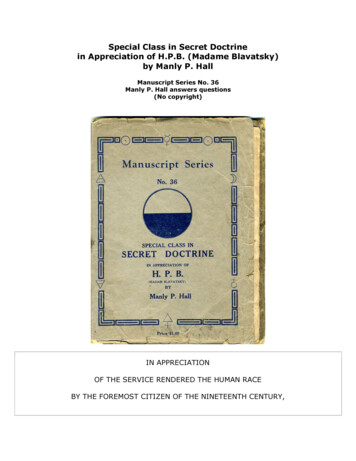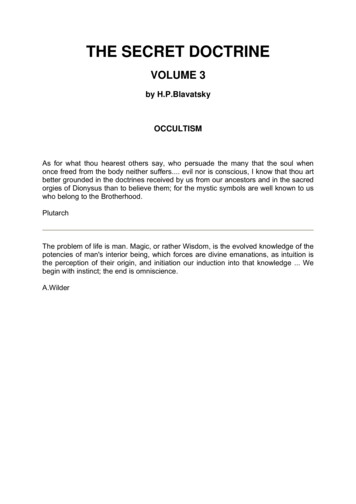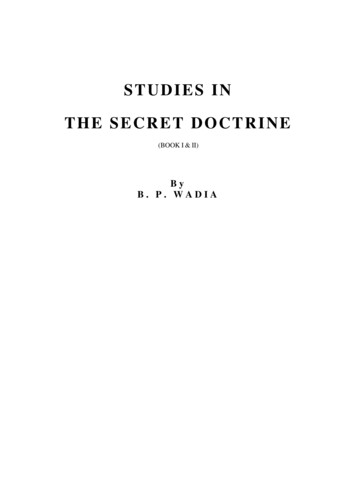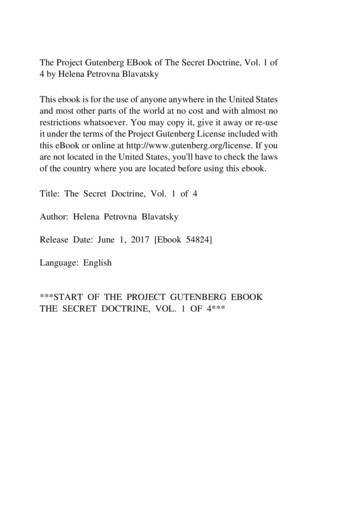
Transcription
The Project Gutenberg EBook of The Secret Doctrine, Vol. 1 of4 by Helena Petrovna BlavatskyThis ebook is for the use of anyone anywhere in the United Statesand most other parts of the world at no cost and with almost norestrictions whatsoever. You may copy it, give it away or re-useit under the terms of the Project Gutenberg License included withthis eBook or online at http://www.gutenberg.org/license. If youare not located in the United States, you'll have to check the lawsof the country where you are located before using this ebook.Title: The Secret Doctrine, Vol. 1 of 4Author: Helena Petrovna BlavatskyRelease Date: June 1, 2017 [Ebook 54824]Language: English***START OF THE PROJECT GUTENBERG EBOOKTHE SECRET DOCTRINE, VOL. 1 OF 4***
The Secret DoctrineThe Synthesis of Science, Religion, andPhilosophyByHelena Petrovna BlavatskyAuthor of “Isis Unveiled.”Third and Revised Edition.SATYÂT NÂSTI PARO DHARMAH.“There is no Religion higher than Truth.”Volume I.CosmogenesisThe Theosophical Publishing HouseLondon1893
ContentsPreface To The First Edition. . . . . . . . . . . . . . . .Preface To The Third And Revised Edition. . . . . . . .Introductory. . . . . . . . . . . . . . . . . . . . . . . . .Proem: Pages From A Pre-Historic Record. . . . . . . .Part I. Cosmic Evolution. . . . . . . . . . . . . . . . . .Seven Stanzas From The “Book Of Dzyan” . . . . .Stanza I. . . . . . . . . . . . . . . . . . . . . .Stanza II. . . . . . . . . . . . . . . . . . . . .Stanza III. . . . . . . . . . . . . . . . . . . . .Stanza IV. . . . . . . . . . . . . . . . . . . . .Stanza V. . . . . . . . . . . . . . . . . . . . .Stanza VI. . . . . . . . . . . . . . . . . . . . .Stanza VII. . . . . . . . . . . . . . . . . . . .Commentaries On The Seven Stanzas And TheirTerms, According To Their Numeration, In Stanzas And Shlokas. . . . . . . . . . . . . . . . .Stanza I. . . . . . . . . . . . . . . . . . . . . .Stanza II. . . . . . . . . . . . . . . . . . . . .Stanza III. . . . . . . . . . . . . . . . . . . . .Stanza IV. . . . . . . . . . . . . . . . . . . . .Stanza V. . . . . . . . . . . . . . . . . . . . .Stanza VI. . . . . . . . . . . . . . . . . . . . .A Digression. . . . . . . . . . . . . . . . . . .Stanza VI.—Continued. . . . . . . . . . . . . .Stanza VII. . . . . . . . . . . . . . . . . . . .Summing Up. . . . . . . . . . . . . . . . . . .Extracts From An Eastern Private Commentary,Hitherto Secret. . . . . . . . . . . . . .Part II. The Evolution Of Symbolism. . . . . . . . . . 296369. 395. 410
ivThe Secret Doctrine, Vol. 1 of 4Section I. Symbolism and Ideographs. . . . . . . . . . 410Section II. The Mystery Language and Its Keys. . . . . 420Section III. Primordial Substance and Divine Thought. 444Section IV. Chaos: Theos: Kosmos. . . . . . . . . . . 468Section V. On the Hidden Deity, Its Symbols and Glyphs.479Section VI. The Mundane Egg. . . . . . . . . . . . . . 493Section VII. The Days and Nights of Brahmâ. . . . . . 507Section VIII. The Lotus, as a Universal Symbol. . . . . 523Section IX. The Moon; Deus Lunus, Phœbe. . . . . . . 534Section X. Tree, Serpent, and Crocodile Worship. . . . 560Section XI. Demon est Deus Inversus. . . . . . . . . . 572Section XII. The Theogony of the Creative Gods. . . . 590Section XIII. The Seven Creations. . . . . . . . . . . . 621Section XIV. The Four Elements. . . . . . . . . . . . . 644Section XV. On Kwan-Shi-Yin and Kwan-Yin. . . . . 658Part III. Addenda. On Occult And Modern Science. . . . . 664Section I. Reasons for These Addenda. . . . . . . . . . 664Section II. Modern Physicists are Playing at BlindMan's Buff. . . . . . . . . . . . . . . . . . . . . 671“An Lumen Sit Corpus, Nec Non?” . . . . . . . 674Section III. Is Gravitation a Law? . . . . . . . . . . . . 683Section IV. The Theories of Rotation in Science. . . . 699Current Hypotheses explaining the Origin of Rotation. . . . . . . . . . . . . . . . . . . . 699Hypotheses of the Origin of Planets and Comets. 700Section V. The Masks of Science. Physics Or Metaphysics? . . . . . . . . . . . . . . . . . . . . . . 710Section VI. An Attack on the Scientific Theory ofForce by a Man of Science. . . . . . . . . . . . . 735Section VII. Life, Force, or Gravity. . . . . . . . . . . 743Section VIII. The Solar Theory. . . . . . . . . . . . . 761Section IX. The Coming Force. Its Possibilities AndImpossibilities. . . . . . . . . . . . . . . . . . . 782Section X. On the Elements and Atoms. . . . . . . . . 800
vSection XI. Ancient Thought in Modern Dress. . . . . 819Section XII. Scientific and Esoteric Evidence for, andObjections to, the Modern Nebular Theory. . . . 833Section XIII. Forces—Modes of Motion or Intelligences?852Section XIV. Gods, Monads and Atoms. . . . . . . . . 865Section XV. Cyclic Evolution and Karma. . . . . . . . 901Section XVI. The Zodiac and its Antiquity. . . . . . . 921Section XVII. Summary of the Position. . . . . . . . . 951Footnotes . . . . . . . . . . . . . . . . . . . . . . . . . . 965
[Transcriber's Note: The above cover image was produced bythe submitter at Distributed Proofreaders, and is being placedinto the public domain.][i]This WorkI Dedicate to all True Theosophists,In every Country,And of every Race,For they called it forth, and for them it was recorded.[xix]
Preface To The First Edition.[xx]The author—the writer, rather—feels it necessary to apologizefor the long delay which has occurred in the appearance of thiswork. It has been occasioned by ill-health and the magnitude ofthe undertaking. Even the two volumes now issued do not complete the scheme, nor do these treat exhaustively of the subjectsdealt with in them. A large quantity of material has already beenprepared, dealing with the history of Occultism as contained inthe lives of the great Adepts of the Âryan Race, and showingthe bearing of Occult Philosophy upon the conduct of life, as itis and as it ought to be. Should the present volumes meet witha favourable reception, no effort will be spared to carry out thescheme of the work in its entirety.This scheme, it must be added, was not in contemplation whenthe preparation of the work was first announced. As originallyannounced, it was intended that The Secret Doctrine should be anamended and enlarged version of Isis Unveiled. It was, however,soon found that the explanations which could be added to thosealready put before the world, in the last-named and other worksdealing with Esoteric Science, were such as to require a differentmethod of treatment; and consequently the present volumes donot contain, in all, twenty pages extracted from Isis Unveiled.The author does not feel it necessary to ask the indulgence ofher readers and critics for the many defects of literary style, andthe imperfect English which may be found in these pages. Sheis a foreigner, and her knowledge of the language was acquiredlate in life. The English tongue is employed because it offers themost widely-diffused medium for conveying the truths which ithad become her duty to place before the world.
Preface To The First Edition.3These truths are in no sense put forward as a revelation; nordoes the author claim the position of a revealer of mystic lore,now made public for the first time in the world's history. Forwhat is contained in this work is to be found scattered throughoutthousands of volumes embodying the Scriptures of the greatAsiatic and early European religions, hidden under glyph andsymbol, and hitherto left unnoticed because of this veil. Whatis now attempted is to gather the oldest tenets together and tomake of them one harmonious and unbroken whole. The soleadvantage which the writer has over her predecessors, is that sheneed not resort to personal speculations and theories. For thiswork is a partial statement of what she herself has been taught bymore advanced students, supplemented, in a few details only, bythe results of her own study and observation. The publication ofmany of the facts herein stated has been rendered necessary by thewild and fanciful speculations in which many Theosophists andstudents of Mysticism have indulged, during the last few years,in their endeavour, as they imagined, to work out a completesystem of thought from the few facts previously communicatedto them.It is needless to explain that this book is not the Secret Doctrine in its entirety, but a select number of fragments of itsfundamental tenets, special attention being paid to some factswhich have been seized upon by various writers, and distortedout of all resemblance to the truth.But it is perhaps desirable to state unequivocally that theteachings, however fragmentary and incomplete, contained inthese volumes, do not belong to the Hindû, the Zoroastrian, theChaldæan, or the Egyptian religion, nor to Buddhism, Islam,Judaism or Christianity exclusively. The Secret Doctrine is theessence of all these. Sprung from it in their origins, the variousreligious schemes are now made to merge back into their originalelement, out of which every mystery and dogma has grown,developed, and become materialized.[xxi]
4[xxii][xxiii]The Secret Doctrine, Vol. 1 of 4It is more than probable that the book will be regarded by alarge section of the public as a romance of the wildest kind; forwho has ever even heard of the Book of Dzyan?The writer, therefore, is fully prepared to take all the responsibility for what is contained in this work, and even to face thecharge of having invented the whole of it. That it has manyshortcomings she is fully aware; all that she claims for it is that,romantic as it may seem to many, its logical coherence and consistency entitle this new Genesis to rank, at any rate, on a levelwith the “working hypotheses” so freely accepted by ModernScience. Further, it claims consideration, not by reason of anyappeal to dogmatic authority, but because it closely adheres toNature, and follows the laws of uniformity and analogy.The aim of this work may be thus stated: to show that Natureis not “a fortuitous concurrence of atoms,” and to assign to manhis rightful place in the scheme of the Universe; to rescue fromdegradation the archaic truths which are the basis of all religions;to uncover, to some extent, the fundamental unity from whichthey all spring; finally, to show that the Occult side of Nature hasnever been approached by the Science of modern civilization.If this is in any degree accomplished, the writer is content. Itis written in the service of humanity, and by humanity and thefuture generations it must be judged. Its author recognizes noinferior court of appeal. Abuse she is accustomed to; calumny sheis daily acquainted with; at slander she smiles in silent contempt.De minimis non curat lex.H. P. B.LONDON, October, 1888.
Preface To The Third And RevisedEdition.In preparing this edition for the press, we have striven to correctminor points of detail in literary form, without touching at allmore important matters. Had H. P. Blavatsky lived to issue thenew edition, she would doubtless have corrected and enlarged itto a very considerable extent. That this is not done is one of themany minor losses caused by the one great loss.Awkward phrases, due to imperfect knowledge of English,have been corrected; most of the quotations have been verified,and exact references given—a work involving great labour, asthe references in the previous editions were often very loose;a uniform system of transliteration for Sanskrit words has beenadopted. Rejecting the form most favoured by Western Orientalists as being misleading to the general reader—we have givento the consonants not present in our English alphabet combinations that approximately express their sound-values, and we havecarefully inserted quantities, wherever they occur, on the vowels.In a few instances we have incorporated notes in the text, butthis has been very sparingly done, and only when they obviouslyformed part of it.We have added a copious Index for the assistance of students,and have bound it separately, so that reference to it may befacilitated. For the great labour in this we, and all students, arethe debtors of Mr. A. J. Faulding.ANNIE BESANT.G. R. S. MEAD.
6The Secret Doctrine, Vol. 1 of 4LONDON, 1893.[001]
Introductory.Gently to hear, kindly to judge.SHAKESPEARE.Since the appearance of Theosophical literature in England, ithas become customary to call its teachings “Esoteric Buddhism.”And, having become a habit—as an old proverb based on dailyexperience has it—“Error runs down an inclined plane, whileTruth has to laboriously climb its way up hill.”Old truisms are often the wisest. The human mind can hardlyremain entirely free from bias, and decisive opinions are oftenformed before a thorough examination of a subject from all itsaspects has been made. This is said with reference to the prevailing double mistake (a) of limiting Theosophy to Buddhism;and (b) of confounding the tenets of the religious philosophypreached by Gautama, the Buddha, with the doctrines broadlyoutlined in Esoteric Buddhism. Any thing more erroneous thanthis could hardly be imagined. It has enabled our enemies to findan effective weapon against Theosophy, because, as an eminentPâli scholar very pointedly expressed it, there was in the volumenamed “neither Esotericism nor Buddhism.” The esoteric truths,presented in Mr. Sinnett's work, ceased to be esoteric fromthe moment they were made public; nor did the book containthe religion of Buddha, but simply a few tenets from a hithertohidden teaching, which are now explained and supplemented bymany more in the present volumes. And even the latter, thoughgiving out many fundamental tenets from the SECRET DOCTRINEof the East, raise but a small corner of the dark veil. For no one,not even the greatest living Adept, would be permitted to, or
8[002]The Secret Doctrine, Vol. 1 of 4could—even if he would—give out promiscuously to a mocking,unbelieving world that which has been so effectually concealedfrom it for long æons and ages.Esoteric Buddhism was an excellent work with a very unfortunate title, though it meant no more than does the title of this work,THE SECRET DOCTRINE. It proved unfortunate, because people arealways in the habit of judging things by their appearance ratherthan by their meaning, and because the error has now becomeso universal, that even most of the Fellows of the TheosophicalSociety have fallen victims to the same misconception. Fromthe first, however, protests were raised by Brâhmans and othersagainst the title; and, in justice to myself, I must add that EsotericBuddhism was presented to me as a completed volume, and that Iwas entirely unaware of the manner in which the author intendedto spell the word “Budh-ism.”This has to be laid directly at the door of those who, havingbeen the first to bring the subject under public notice, neglectedto point out the difference between “Buddhism”—the religioussystem of ethics preached by the Lord Gautama, and so namedfrom his title of Buddha, the “Enlightened”—and “Budhism,”from Budha, Wisdom, or Knowledge (Vidyâ), the faculty of cognizing, from the Sanskrit root Budh, to know. We Theosophistsof India are ourselves the real culprits, although, at the time, wedid our best to correct the mistake.1 To avoid this deplorablemisnomer was easy; the spelling of the word had only to bealtered, and by common consent both pronounced and written“Budhism,” instead of “Buddhism.” Nor is the latter term correctly spelt and pronounced, as it ought to be called, in English,Buddhaïsm, and its votaries “Buddhaïsts.”This explanation is absolutely necessary at the beginning of awork like the present. The Wisdom-Religion is the inheritance ofall the nations, the world over, in spite of the statement made in1See Theosophist, June, 1883.
Introductory.9Esoteric Buddhism2 that “two years ago (i.e., in 1883), neither I,nor any other European living, knew the alphabet of the Science,here for the first time put into a scientific shape,” etc. This errormust have crept in through inadvertence. The present writerknew all that is “divulged” in Esoteric Buddhism, and muchmore, many years before it became her duty (in 1880) to impart asmall portion of the Secret Doctrine to two European gentlemen,one of whom was the author of Esoteric Buddhism; and surely thepresent writer has the undoubted, though to her, rather equivocal,privilege of being a European by birth and education. Moreover,a considerable part of the philosophy expounded by Mr. Sinnettwas taught in America, even before Isis Unveiled was published,to two Europeans and to my colleague, Colonel H. S. Olcott. Ofthe three teachers the latter gentleman has had, the first was aHungarian Initiate, the second an Egyptian, the third a Hindû.As permitted, Colonel Olcott has given out some of this teachingin various ways; if the other two have not, it has been simplybecause they were not allowed, their time for public work havingnot yet come. But for others it has, and the appearance of Mr.Sinnett's several interesting books is a visible proof of the fact.Moreover, it is above everything important to keep in mind thatno Theosophical book acquires the least additional value frompretended authority.Âdi, or Âdhi Budha, the One, or the First, and SupremeWisdom, is a term used by Âryâsanga in his secret treatises, andnow by all the mystic Northern Buddhists. It is a Sanskrit term,and an appellation given by the earliest Âryans to the UnknownDeity; the word “Brahmâ” not being found in the Vedas andthe early works. It means the Absolute Wisdom, and Âdibhûtais translated by Fitzedward Hall, “the primeval uncreated causeof all.” Æons of untold duration must have elapsed, before theepithet of Buddha was so humanized, so to speak, as to allow of2Preface to the original edition.[003]
10The Secret Doctrine, Vol. 1 of 4the term being applied to mortals, and finally appropriated to onewhose unparalleled virtues and knowledge caused him to receivethe title of the “Buddha of Wisdom Unmoved.” Bodha means theinnate possession of divine intellect or understanding; Buddha,the acquirement of it by personal efforts and merit; while Buddhiis the faculty of cognizing, the channel through which divineknowledge reaches the Ego, the discernment of good and evil, also divine conscience, and the Spiritual Soul, which is the vehicleof Âtmâ. “When Buddhi absorbs our Ego-tism (destroys it) withall its Vikâras, Avalokiteshvara becomes manifested to us, andNirvâna, or Mukti, is reached,” Mukti being the same as Nirvana,i.e., freedom from the trammels of Mâyâ or Illusion. Bodhi islikewise the name of a particular state of trance-condition, calledSamâdhi, during which the subject reaches the culmination ofspiritual knowledge.[004]Unwise are those who, in their blind and, in our age, untimelyhatred of Buddhism, and, by reäction, of Budhism, deny itsesoteric teachings, which are those also of the Brâhmans, simplybecause the name suggests what to them, as Monotheists, arenoxious doctrines. Unwise is the correct term to use in their case.For in this age of crass and illogical materialism, the EsotericPhilosophy alone is calculated to withstand the repeated attackson all and everything man holds most dear and sacred in hisinner spiritual life. The true philosopher, the student of EsotericWisdom, entirely loses sight of personalities, dogmatic beliefsand special religions. Moreover, Esoteric Philosophy reconcilesall religions, strips every one of its outward human garments,and shows the root of each to be identical with that of everyother great religion. It proves the necessity of a Divine AbsolutePrinciple in Nature. It denies Deity no more than it does the sun.Esoteric Philosophy has never rejected God in Nature, nor Deityas the absolute and abstract Ens. It only refuses to accept anyof the gods of the so-called monotheistic religions, gods createdby man in his own image and likeness, a blasphemous and sorry
Introductory.11caricature of the Ever-Unknowable. Furthermore, the recordswe mean to place before the reader embrace the esoteric tenetsof the whole world since the beginning of our humanity, andBuddhistic Occultism occupies therein only its legitimate place,and no more. Indeed, the secret portions of the Dan or Janna(Dhyâna)3 of Gautama's metaphysics—grand as they appear toone unacquainted with the tenets of the Wisdom-Religion ofantiquity—are but a very small portion of the whole. The Hindûreformer limited his public teachings to the purely moral andphysiological aspect of the Wisdom-Religion, to ethics and manalone. Things “unseen and incorporeal,” the mysteries of Beingoutside our terrestrial sphere, the great Teacher left entirely untouched in his public lectures, reserving the Hidden Truths for aselect circle of his Arhats. The latter received their Initiation atthe famous Saptaparna Cave (the Sattapanni of Mahâvansa) nearMount Baibhâr (the Webhâra of the Pâli MSS.). This cave wasin Râjâgriha, the ancient capital of Magadha, and was the ChetaCave of Fa-hian, as is rightly suspected by some archaeologists.4Time and human imagination made short work of the purityand philosophy of these teachings, once that they were transplanted from the secret and sacred circle of the Arhats, duringthe course of their work of proselytism, into a soil less preparedfor metaphysical conceptions than India; i.e., once they weretransferred into China, Japan, Siam, and Burmah. How the pristine purity of these grand revelations was dealt with may be seenin studying some of the so-called “esoteric” Buddhist schoolsof antiquity in their modern garb, not only in China and otherBuddhist countries in general, but even in not a few schools of3Dan, in modern Chinese and Tibetan phonetics Chhan, is the general termfor the esoteric schools and their literature. In the old books, the word Janna isdefined as “reforming one's self by meditation and knowledge,” a second innerbirth. Hence Dzan, Djan phonetically; the Book of Dzyan. See Edkins, ChineseBuddhism, p. 129, note.4Mr. Beglor, the chief engineer at Buddhagâya, and a distinguished archæologist, was the first, we believe, to discover it.[005]
12The Secret Doctrine, Vol. 1 of 4Tibet, which have been left to the care of uninitiated Lamas andMongolian innovators.Thus the reader is asked to bear in mind the very important difference between orthodox Buddhism—i.e., the public teachingsof Gautama, the Buddha—and his esoteric Budhism. His SecretDoctrine, however, differed in no wise from that of the initiatedBrahmans of his day. The Buddha was a child of Âryan soil, aborn Hindû, a Kshatriya and a disciple of the Twice-born (theinitiated Brâhmans) or Dvîjas. His teachings, therefore, couldnot be different from their doctrines, for the whole Buddhistreform consisted merely in giving out a portion of that whichhad been kept secret from every man outside of the “enchanted”circle of ascetics and Temple-Initiates. Unable, owing to hispledges, to teach all that had been imparted to him, though theBuddha taught a philosophy built upon the ground-work of thetrue esoteric knowledge, he gave to the world only its outwardmaterial body and kept its soul for his Elect. Many Chinesescholars among Orientalists have heard of the “Soul-Doctrine.”None seem to have understood its real meaning and importance.That doctrine was preserved secretly—too secretly, perhaps—within the sanctuary. The mystery that shrouded itschief dogma and aspiration—Nirvâna—has so tried and irritatedthe curiosity of those scholars who have studied it, that, unableto solve it logically and satisfactorily by untying its Gordianknot, they have cut it through by declaring that Nirvâna meansabsolute annihilation.Toward the end of the first quarter of this century a distinctclass of literature appeared in the world, which with every yearbecame more defined in its tendency. Being based, soi-disant,on the scholarly researches of Sanskritists and Orientalists ingeneral, it was considered scientific. Hindû, Egyptian, and otherancient religions, myths, and emblems were made to yield anything the symbologist wanted them to yield, and thus often therude outward form was given out in place of the inner meaning.
Introductory.13Works, most remarkable for their ingenious deductions and speculations, circulo vicioso—foregone conclusions generally takingthe place of premisses in the syllogisms of more than one Sanskritand Pâli scholar—appeared rapidly in succession, over-floodingthe libraries with dissertations on phallic and sexual worshiprather than on real symbology, and each contradicting the other.This is the true reason, perhaps, why the outline of a fewfundamental truths from the Secret Doctrine of the ArchaicAges is now permitted to see the light, after long millenniumsof the most profound silence and secrecy. I say advisedly “afew truths,” because that which must remain unsaid could not becontained in a hundred such volumes, nor could it be impartedto the present generation of Sadducees. But even the little thatis now given is better than complete silence upon these vitaltruths. The world of to-day, in its mad career towards the unknown, which the Physicist is too ready to confound with theunknowable, whenever the problem eludes his grasp, is rapidlyprogressing on the reverse plane to that of spirituality. It has nowbecome a vast arena, a true valley of discord and of eternal strife,a necropolis, wherein lie buried the highest and the most holyaspirations of our Spirit-Soul. That soul becomes with every newgeneration more paralyzed and atrophied. The “amiable infidelsand accomplished profligates” of Society, spoken of by Greeley,care little for the revival of the dead sciences of the past; butthere is a fair minority of earnest students who are entitled tolearn the few truths that may be given to them now; and nowmuch more than ten years ago, when Isis Unveiled appeared, oreven when the later attempts to explain the mysteries of esotericscience were published.One of the greatest and perhaps the most serious objectionto the correctness and reliability of the whole work will be thepreliminary Stanzas. How can the statements contained in thembe verified? True, though a great portion of the Sanskrit, Chinese,and Mongolian works quoted in the present volumes is known[006]
14[007]The Secret Doctrine, Vol. 1 of 4to some Orientalists, yet the chief work—that one from whichthe Stanzas are given—is not in the possession of European Libraries. THE BOOK OF DZYAN (or DZAN) is utterly unknown to ourPhilologists, or at any rate was never heard of by them under itspresent name. This is, of course, a great drawback to those whofollow the methods of research prescribed by official Science;but to students of Occultism, and to every genuine Occultist, thiswill be of little moment. The main body of the doctrines given,however, is found scattered throughout hundreds and thousandsof Sanskrit MSS., some already translated—disfigured in theirinterpretations, as usual—others still waiting their turn. Everyscholar, therefore, has an opportunity of verifying the statementsherein made, and of checking most of the quotations. A few newfacts, new to the profane Orientalist only, and passages quotedfrom the Commentaries will be found difficult to trace. Severalof the teachings also have hitherto been transmitted orally, yeteven these in every instance are hinted at in the almost countlessvolumes of Brâhmanical, Chinese and Tibetan temple-literature.However it may be, and whatsoever is in store for the writerthrough malevolent criticism, one fact is quite certain. The members of several esoteric schools—the seat of which is beyondthe Himâlayas, and whose ramifications may be found in China,Japan, India, Tibet, and even in Syria, and also South America—claim to have in their possession the sum total of sacred andphilosophical works in MSS. and print, all the works, in fact, thathave ever been written, in whatever language or character, sincethe art of writing began, from the ideographic hieroglyphs downto the alphabet of Cadmus and the Devanâgari.It has been constantly claimed that, ever since the destructionof the Alexandrian Library,5 every work of a character that mightlead the profane to the ultimate discovery and comprehensionof some of the mysteries of the Secret Science, owing to the5See Isis Unveiled, Vol. II, p. 27.
Introductory.15combined efforts of the members of these Brotherhoods, hasbeen diligently searched for. It is added, moreover, by those whoknow, that once found all such works were destroyed, save threecopies of each which were preserved and safely stored away. InIndia, the last of these precious manuscripts were secured andhidden during the reign of the Emperor Akbar.Prof. Max Müller shows that no bribes or threats of Akbarcould extort the original text of the Vedas from the Brâhmans,and yet boasts that European Orientalists have it.6 That Europehas the complete text is exceedingly doubtful, and the future mayhave very disagreeable surprises in store for the Orientalists.It is maintained, furthermore, that every sacred book of thiskind, the text of which was not sufficiently veiled in symbolism,or which had any direct references to the ancient mysteries, wasfirst carefully copied in cryptographic characters, such as to defythe art of the best and cleverest palæographer, and then destroyedto the last copy. During Akbar's reign, some fanatical courtiers,displeased at the Emperor's sinful prying into the religions of theinfidels, themselves helped the Brâhmans to conceal their MSS.Such was Badáoní, who had an undisguised horror of Akbar'smania for idolatrous religions.Badáoní, in his Muntakhab at Tawarikh, writes:As they [the Shramana and Brâhmans] surpass other learnedmen in their treatises on morals and on physical and religioussciences, and reach a high degree in their knowledge of thefuture, in spiritual power, and human perfection, they broughtproofs
4 The Secret Doctrine, Vol. 1 of 4 It is more than probable that the book will be regarded by a large section of the public as a romance of the wildest kind; for who has ever even heard of the Book of Dzyan? The wri
